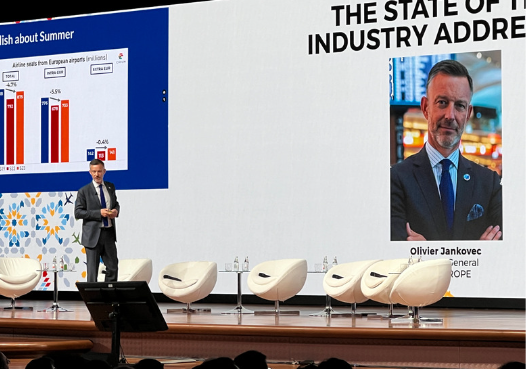Airports nudge back into black – with business transformation challenge ahead

“The mother of all challenges for European airports will be decoupling financial viability and profitability from volume growth – to ensure not just resilience but also future proofing” says ACI EUROPE’s Jankovec in annual State of the Industry address
Barcelona, 27 June 2023: After more than €50 billion in foregone revenues and over €20 billion in accumulated losses since 2019, Europe’s airports were back in the black last year – posting a net profit of €6.4 billion. This opening salvo from ACI EUROPE’s Director General, Olivier Jankovec, in his annual State of the Industry address today opened the 33rd Annual Congress and General Assembly in Barcelona with a much-needed message of positivity.
This performance was achieved in a context where passenger volumes still remained 21% below pre-pandemic (2019) levels. It was primarily driven by airports delivering cost efficiencies despite unprecedented inflationary pressures and significantly slashing investments - with capital expenditure decreasing by -€5.5 billion. Another key contributing factor was airports working with their business partners to seize the momentum in consumer spending to increase their non-aeronautical revenues, in particular from retail, and food and beverage activities.
But looking ahead, the financial situation of Europe’s airports remains uncertain and challenging - due to the combination of both structural cost increases and structural revenue pressures:
- Debt and liabilities remain a staggering €47 billion above pre-pandemic levels, as airports benefitted from much less State largesse than airlines during the pandemic and had no option other than to pile on debt.
- Along with debt servicing, inflation has been driving external costs to record levels – with operating costs such as utilities and supplies increasing by +78% and +62% compared to pre-pandemic1. And despite much reduced investment, capital costs also increased by +22%2 with both interest rates and depreciation costs rising.
- Last but not least, despite the fact that the price of air travel for consumers has ballooned, charges paid by airlines for the use of airport facilities tend to remain below cost coverage. While the air fares charged by airlines have increased by +32% compared to pre-pandemic prices3, airport charges are up by just +7% - meaning they have actually decreased in real terms.
Jankovec warned that overall the current dynamic is therefore not sustainable, also pointing to investors now also erring on the side of caution4 as the industry regroups and remodels:
“What is at stake here is airports’ ability to invest in their decarbonisation, resilience, digitalisation and capacity where needed. Looking at 2023 and the next 2 years, Europe’s airports already cut planned investments from €34.6 billion to €18.4 billion. The investment crunch is not for tomorrow – it is already a reality.
So there really is only one logical way forward, and that is adherence to the user pays principle. Regulators and governments need to accept the fact that cost pressures and investment needs require an upward adjustment of airport charges.”
Twin determinants: the new aviation market structure and the decarbonisation imperative
Two concurrent determinants are now transforming the airport business model as a whole:
- The first is the new, post Covid reality of the European aviation market, which is characterised by relentless yet selective expansion from ultra-Low Cost Carriers along with the relative retrenchment and consolidation of Full Service Carriers.
- The decarbonisation imperative, inextricably linked to the industry’s license to keep operating.
The combination of these two factors will result in continued competitive pressures upon airports in a context of slower traffic growth, said Jankovec. This means the key challenge for European airports will be the decoupling of financial viability and profitability from volume growth – to ensure not just resilience but also future proofing. This will require achieving growth in unit revenues.
Looking ahead: A new airport value model of glocal businesses - built around the green energy transition
Jankovec concluded his address by outlining the evolution of the airport business model towards a new value creation model based on 3 pillars: sustainability, innovation and diversification.
The challenges and opportunities presented by the energy transition which decarbonisation involves are not just true of aviation but of the entire economy. This, argued Jankovec, is an opportunity for airports to evolve to also become ENERports – acting as energy hubs and providers of green energy not just to respond to the needs of air connectivity but to meet the wider needs of their communities.
“The seismic shift in the economy as the decarbonisation imperative gathers pace comes with the opportunity to redefine and enlarge the societal role and relevance of airports” he said. “The local value of an airport has long been part and parcel of our nations and regions. Now, we need to take this to the next level with the generation and supply of green energy for aviation and our surrounding communities alike.”

